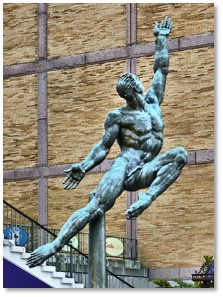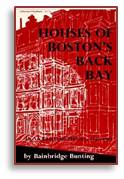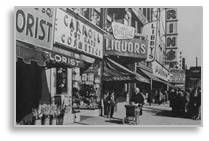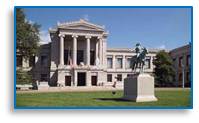When I studied at @Northeastern University, Boston was a very different city from the one we see now. It was smaller: metro Boston’s population was only about 3.5 million. It was lower. The Prudential Center—the city’s tallest building—was new but the Hancock Tower had not yet risen and buildings in the Financial District seldom reached over 10 stories high. The Seaport District, Faneuil Hall Market, the Convention Center and Copley Place didn’t exist.
A Less-Visible Difference
There was another, less visible difference, however. It lay in the attitude of the people and was reflected in the city‘s overall appearance.
Boston was dingier. The streets and sidewalks were dirty and choked with litter of all kinds. Ditto squares and parks, where grass had been beaten into bare, pounded dirt. Fountains didn’t work and the frog pond was an abandoned oval of cracked concrete. Restaurants, dark and staid, offered the same traditional food for decades.
 Aside from the Pru, new construction was largely a government matter with the Federal Reserve building, Government Center, and the Federal office buildings accounting for most of it. The city’s legitimate theaters and the Opera House were closing. Boston’s persona approached one of genteel poverty—run-down at the heels, patched at the elbows and just hanging on.
Aside from the Pru, new construction was largely a government matter with the Federal Reserve building, Government Center, and the Federal office buildings accounting for most of it. The city’s legitimate theaters and the Opera House were closing. Boston’s persona approached one of genteel poverty—run-down at the heels, patched at the elbows and just hanging on.
Just Holding On
The Museum of Fine Arts offered a prime example. The grande dame of Boston’s art scene opened in 1876 and has been in its stately Fenway location since 1909. Under financial pressure, @MFAboston closed its impressive main door and the beautiful Fenway Drive entrance in 1990. Visitors had only one way in: through an unimpressive entrance from the parking lot. The MFA presented a perception to the public that its goal was to conserve, protect, hold on to what they already had—and no more.
When Boston did finally turn around, it was largely due to the efforts of people from other parts of the country and other countries. More on that later.
 The question I asked was—why? Why did a city with so much going for it have such a seemingly low opinion of itself? Why was it so risk averse, its vision so narrow, its ambitions so limited?
The question I asked was—why? Why did a city with so much going for it have such a seemingly low opinion of itself? Why was it so risk averse, its vision so narrow, its ambitions so limited?The Spendthrift Trusts
Mr. Bunting notes that the early nineteenth century was a period of, “economic expansion and civic improvement” in Boston when the city was “a serious contender with New York for the leadership of American finance and commerce.” But that leveled off. “Not suddenly, but unmistakably, the earlier expansive progressive Boston now turned her attention to one of complacency and fulfillment. Heretofore progressive Boston now turned her attention to the maintenance of the status quo.” While the author finds it difficult to pin down exactly the change took place, he is sure it had occurred by 1890.
Trading Risk for Safety
For an answer, he looks even further back, to Boston native Frederic J. Stimson’s book, My United States. Mr. Stimson gave the reason as “spendthrift trusts.” He goes on to say that around 1830, the Massachusetts courts decided that:
“… a man could tie his children’s inheritance up either by deed or will, so that he could not spend or risk his principal or, indeed, embark in any business. Immense wealth had been accumulated in Boston in the first sixty years of the republic, but instead of trusting their sons and sending them out at their own risks with all their argosies upon life’s seas, as they themselves had done, they distrusted their abilities and had them all trusteed.”
Conservative Traditions
Think about that. Imagine what today’s world would be like if @Bill Gates’s father hadn’t given him $50,000 in seed money, for example. Stimson continues,
“No new enterprise could be undertaken by them for under court decision they had no capital to risk. Perforce they became coupon cutters, not promoters of industry. The result of making Boston’s youth mere four-percent men was to choke off their own energies and largely to divorce business and the Brahmins.” (pp. 16-17)
Mr. Bunting goes on to give multiple examples of times when Boston financiers and cultural mavens made conservative decisions that make you laugh and curl your hair at the same time.
Does the Answer Still Have Power?
Finally I had my answer—or at least a good answer. My question now is how much that attitude, now over a century old, still affects today’s Boston? Is this native caution why more California companies buy Massachusetts start-ups than the other way around? Is this caution why most of our home-grown banks have disappeared, acquired instead of growing by their own acquisitions? Are these conservative decisions why big companies like Polaroid, Digital Equipment, and Prime Computer don’t exist anymore?
The MFA was brought into the twentieth century by Malcolm Rogers, a native of Britain, who became director in 1994 and saved the museum from its inbred Brahmin roots. In 1995 he undertook the then-audacious action of renovating and re-opening the main entrance and, in 2008, the Fenway entrance. Although he has accomplished many extraordinary things since then—things no post-1890 Beacon Hill Bostonian could have conceived of—nothing else offers a better metaphor for a non-Bostonian letting in the fresh air of ambitious thinking.


